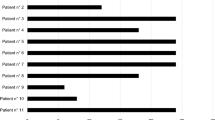Abstract
In this study, we compared the long-term effects of different iron chelation regimens (deferoxamine, deferiprone, deferoxamine + deferiprone, and deferasirox) in preventing or reversing endocrinopathy (diabetes mellitus, hypothyroidism, or hypogonadism) and bone disease (measured through DEXA) in 165 adults with β-thalassemia major (TM) (mean age 39.9 ± 8.3 years, 43 % males). After five consecutive years of therapy, patients on deferasirox had the highest decrease in the prevalence of any endocrinopathy compared to other chelators which either had no change (deferiprone and deferoxamine) or had an increase (deferoxamine + deferiprone), p = 0.015. This was attributed to a lower proportion of patients on deferasirox developing new-onset endocrinopathy and higher proportion showing reversal of disease, compared to other chelators. A serum ferritin level of >1300 ng/mL predicted the development of new endocrinopathy (p = 0.025) while a level of <200 ng/mL predicted reversal of existing endocrinopathy (p = 0.147). A significant increase in mean BMD T-score (p < 0.001) and a considerable decrease in osteoporosis prevalence were observed in patients receiving deferasirox but not other chelators. Iron chelation therapy with deferasirox has a role in the prevention of endocrinopathy and reversal of existing disease.




Similar content being viewed by others
References
Borgna-Pignatti C, Rugolotto S, De Stefano P, Zhao H, Cappellini MD, Del Vecchio GC, Romeo MA, Forni GL, Gamberini MR, Ghilardi R, Piga A, Cnaan A (2004) Survival and complications in patients with thalassemia major treated with transfusion and deferoxamine. Haematologica 89:1187–1193
Habeb AM, Al-Hawsawi ZM, Morsy MM, Al-Harbi AM, Osilan AS, Al-Magamsi MS, Zolaly MA (2013) Endocrinopathies in beta-thalassemia major. Prevalence, risk factors, and age at diagnosis in Northwest Saudi Arabia. Saudi Med J 34:67–73
Gamberini MR, De Sanctis V, Gilli G (2008) Hypogonadism, diabetes mellitus, hypothyroidism, hypoparathyroidism: incidence and prevalence related to iron overload and chelation therapy in patients with thalassaemia major followed from 1980 to 2007 in the Ferrara Centre. Pediatr Endocrinol Rev 6(Suppl 1):158–169
Cunningham MJ, Macklin EA, Neufeld EJ, Cohen AR, Thalassemia Clinical Research N (2004) Complications of beta-thalassemia major in North America. Blood 104:34–39
Noetzli LJ, Panigrahy A, Mittelman SD, Hyderi A, Dongelyan A, Coates TD, Wood JC (2012) Pituitary iron and volume predict hypogonadism in transfusional iron overload. Am J Hematol 87:167–171
Noetzli LJ, Mittelman SD, Watanabe RM, Coates TD, Wood JC (2012) Pancreatic iron and glucose dysregulation in thalassemia major. Am J Hematol 87:155–160
Belhoul KM, Bakir ML, Saned MS, Kadhim AM, Musallam KM, Taher AT (2012) Serum ferritin levels and endocrinopathy in medically treated patients with beta thalassemia major. Ann Hematol 91:1107–1114
Haidar R, Musallam KM, Taher AT (2011) Bone disease and skeletal complications in patients with beta thalassemia major. Bone 48:425–432
Casale M, Citarella S, Filosa A, De Michele E, Palmieri F, Ragozzino A, Amendola G, Pugliese U, Tartaglione I, Della Rocca F, Cinque P, Nobili B, Perrotta S (2014) Endocrine function and bone disease during long-term chelation therapy with deferasirox in patients with beta-thalassemia major. Am J Hematol 89:1102–1106
Farmaki K, Tzoumari I, Pappa C, Chouliaras G, Berdoukas V (2010) Normalisation of total body iron load with very intensive combined chelation reverses cardiac and endocrine complications of thalassaemia major. Br J Haematol 148:466–475
Farmaki K, Tzoumari I, Pappa C (2011) Oral chelators in transfusion-dependent thalassemia major patients may prevent or reverse iron overload complications. Blood Cells Mol Dis 47:33–40
Cappellini MD, Bejaoui M, Agaoglu L, Canatan D, Capra M, Cohen A, Drelichman G, Economou M, Fattoum S, Kattamis A, Kilinc Y, Perrotta S, Piga A, Porter JB, Griffel L, Dong V, Clark J, Aydinok Y (2011) Iron chelation with deferasirox in adult and pediatric patients with thalassemia major: efficacy and safety during 5 years’ follow-up. Blood 118:884–893
Pennell DJ, Porter JB, Cappellini MD, Chan LL, El-Beshlawy A, Aydinok Y, Ibrahim H, Li CK, Viprakasit V, Elalfy MS, Kattamis A, Smith G, Habr D, Domokos G, Roubert B, Taher A (2012) Deferasirox for up to 3 years leads to continued improvement of myocardial T2* in patients with beta-thalassemia major. Haematologica 97:842–848
Deugnier Y, Turlin B, Ropert M, Cappellini MD, Porter JB, Giannone V, Zhang Y, Griffel L, Brissot P (2011) Improvement in liver pathology of patients with beta-thalassemia treated with deferasirox for at least 3 years. Gastroenterology 141:1202–1211
Forni GL, Podesta M, Musso M, Piaggio G, Musallam KM, Balocco M, Pozzi S, Rosa A, Frassoni F (2013) Differential effects of the type of iron chelator on the absolute number of hematopoietic peripheral progenitors in patients with beta-thalassemia major. Haematologica 98:555–559
Acknowledgments
The authors thank Khaled Musallam, MD PhD, of EVIDA MEDICAL LTD, London, UK, for the medical editorial assistance. Financial support for medical editorial assistance was provided by Novartis Farma SpA.
Author’s contributions
MP was responsible for the study’s concept design, for data analysis and interpretation, and for drafting the manuscript. All of the authors were responsible for the data collection and assembly, for the manuscript’s critical revision for intellectual content, and for approving the manuscript prior to submission.
Author information
Authors and Affiliations
Corresponding author
Ethics declarations
Conflict of interest
The authors declare that they have no conflict of interest.
Sources of funding
None.
Rights and permissions
About this article
Cite this article
Poggi, M., Sorrentino, F., Pugliese, P. et al. Longitudinal changes of endocrine and bone disease in adults with β-thalassemia major receiving different iron chelators over 5 years. Ann Hematol 95, 757–763 (2016). https://doi.org/10.1007/s00277-016-2633-y
Received:
Accepted:
Published:
Issue Date:
DOI: https://doi.org/10.1007/s00277-016-2633-y




